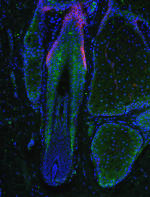It has long been thought that the genes for common baldness come from the mother side of the family – explaining why a male whose maternal grandfather is bald is more likely to lose his hair than if his own father were bald. This observation was recently supported by the discovery of the androgen receptor (AR) gene which resides on the X-chromosome.
Remember, there are two sex chromosomes; X and Y. Females have two X chromosomes (XX), while males have one X and one Y chromosome (XY). This means that a male must get his X chromosome from the mother.
But we all have seen that some bald sons have bald fathers, even when no one on the mother’s side of the family has any hair loss. This suggests that the genetics of male pattern alopecia is more complicated, with multiple genes influencing hair growth. And it is likely that the inheritance of baldness is polygenetic, with relevant genes coming from both the x-chromosome of the mother and non-sex chromosomes of either parent. So where are the other genes?
Two independent research groups, one from England and the other Germany, both published in the journal Nature Genetics, have identified a gene locus p11 on chromosome 20 that seems to be correlated with male pattern hair loss, and since the gene is on a non-sex chromosome, it offers an explanation for why the inheritance of common baldness can be from either side of the family. It is important to emphasize that like the AR gene, the chromosome 20p11 locus has only been shown to correlate with hair loss. It is not been shown that either of these genes actually cause baldness.
Unlike many genes whose expression is one or the other (i.e. blue eyes or brown), the 20p11 variations tend to be additive; therefore, men with one affected copy will have a 3.7 fold increase in the chance of having early hair loss and those with two copies a 6.1 fold increase. Men with both the chromosome 20p11 variation and the AR gene will have a seven-fold increase of developing male pattern hair loss at an early age. This gene combination occurs in about 15% of Caucasian men.
The mainstay of predicting future hair loss is with a Densitometer – an instrument used by physicians to measure changes in hair shaft diameter (miniaturization). According to Dr. Robert Bernstein, “Looking at hair shafts under a microscope can spot shrinkage years before it is apparent – we can pick it up when kid are still teenagers.” Early diagnosis is important in androgenetic alopeica because medication is useful only if the hair loss is not too advanced. The genetic studies are significant in that they supply the physician with one more piece of information when developing a master plan for treating a person’s hair loss. See the article in the Wall Street Journal titled, Hair Apparent? New Science on the Genetics of Balding.
While researchers consider these latest discoveries to be of significant merit, caution must be made since these genes are felt to be associated with hair loss, but not yet shown to be causative. More importantly, the associations are not absolute. A clinical evaluation is still the most reliable indicator of future hair loss. Finally, the ability to identify associated genes does not suggest that a “cure” for male pattern baldness is imminent.
Reference
“On the Genetics of Balding,” Wall Street Journal, Vol. 4 – October 1, 2008.
Posted by Robert M. Bernstein M.D. 



 Dr. Angela Christiano, a colleague of Dr. Bernstein’s at Columbia University, has been studying the causes of alopecia areata and genetic hair loss for many years. She, in fact, suffers from the disease as well.
Dr. Angela Christiano, a colleague of Dr. Bernstein’s at Columbia University, has been studying the causes of alopecia areata and genetic hair loss for many years. She, in fact, suffers from the disease as well.



